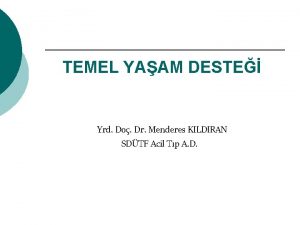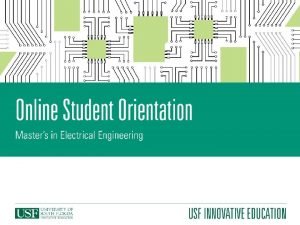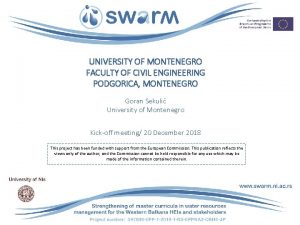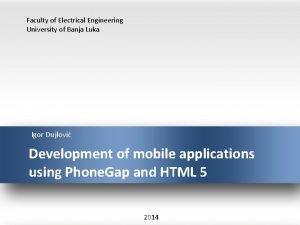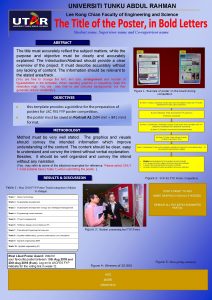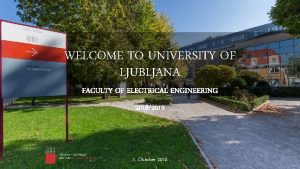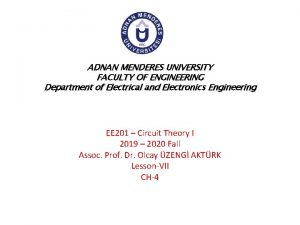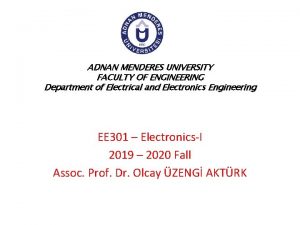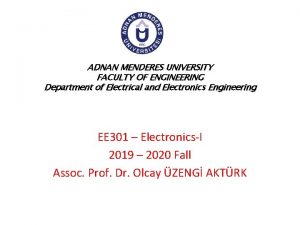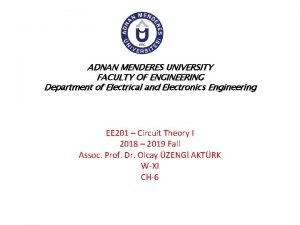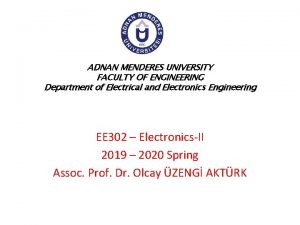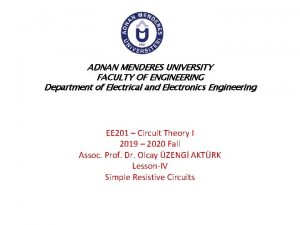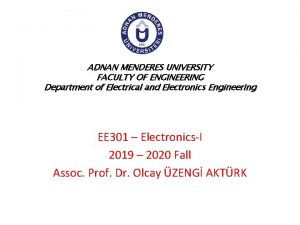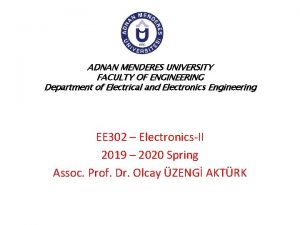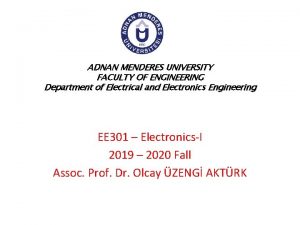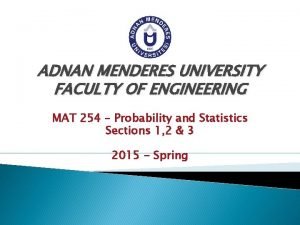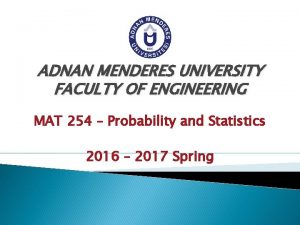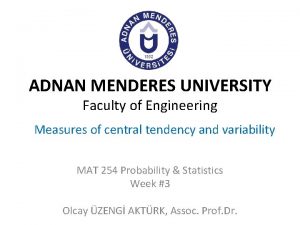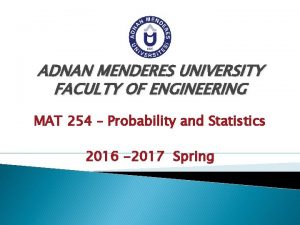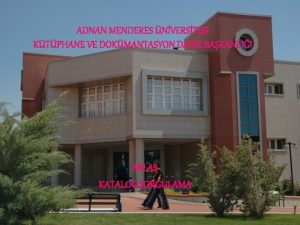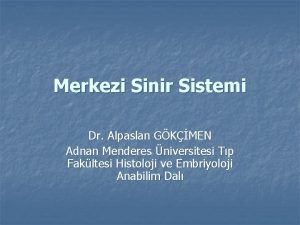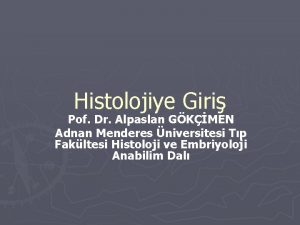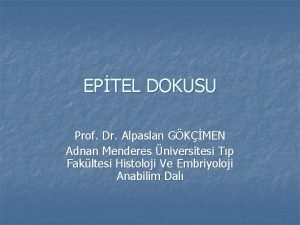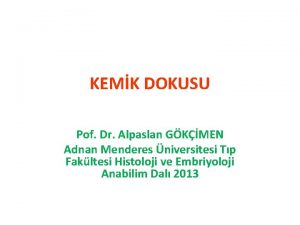ADNAN MENDERES UNIVERSITY FACULTY OF ENGINEERING Department of




























- Slides: 28

ADNAN MENDERES UNIVERSITY FACULTY OF ENGINEERING Department of Electrical and Electronics Engineering EE 201 – Circuit Theory I 2019 – 2020 Fall Assoc. Prof. Dr. Olcay ÜZENGİ AKTÜRK

Course Information Ø Instructor Assoc. Prof. Dr. Olcay ÜZENGİ AKTÜRK Ø Schedule Monday 10: 30 -12: 15 Thursday 10. 30 -12. 15 Ø Office Hours Ø Monday 13. 30 -14. 30 EE 201 -Circuit Theory I, Assoc. Prof. Dr. Olcay ÜZENGİ AKTÜRK, 2019 -2020 Fall

Course Information Ø Texbook Electric Circuits, J. W. Nilsson and S. A. Riedel, 10 th. Ed. Pearson Prentice Hall. Ø Refence Books Fundamentals of Electric Circuits, C. K. Alexander and M. N. O. Sadiku, Mc. Graw-Hill Book Company. Linear and Nonlinear Circuits, L. O. Chua, C. A. Desoer, E. S. Kuh, Mc. Graw-Hill Book Company EE 201 -Circuit Theory I, Assoc. Prof. Dr. Olcay ÜZENGİ AKTÜRK, 2019 -2020 Fall

Ø Homeworks Usually there will be a homework for each 2 -3 weeks. Ø Expectations We expect that the work you submit to us under your name is yours. Interactions of students on the problems are useful and are encouraged, but each person should work on his/her solution. Copying from others is immature, dishonest and waste of everyone’s time. Attendance is mandatory. A student has to attend 50% of the lectures in a semester. If a student does not attend more than 50% of the lectures it fails and it is not permitted to enter the final examination. EE 201 -Circuit Theory I, Assoc. Prof. Dr. Olcay ÜZENGİ AKTÜRK, 2019 -2020 Fall

• • Grades will be determined as follows: Midterm: 35% Final exam: 45% Homework 20% • Total: 100% Announcements: E-mail will be used to send important announcements, it is therefore important for you to check your email regularly. Cell phones are not allowed to be used in class. Students using cell phone for any purpose in class (other than an emergency) will be asked to leave the class. EE 201 -Circuit Theory I, Assoc. Prof. Dr. Olcay ÜZENGİ AKTÜRK, 2019 -2020 Fall

TOPICS Ø Circuit Variables (Chapter 1 of Nilsson) Ø Circuit Elements (Chapter 2 of Nilsson) Ø Simple Resistive Circuit: Series and Parallel Circuits (Chapter 3 of Nilsson) Ø Voltage and Current Divider Circuits (Chapter 3 of Nilsson) Ø Techniques of Circuit Analysis (Chapter 4 of Nilsson) Ø After the midterm… EE 201 -Circuit Theory I, Assoc. Prof. Dr. Olcay ÜZENGİ AKTÜRK, 2019 -2020 Fall

Ø The Operational Amplifier (Chapter 5 of Nilsson) Ø Capacitors and Inductors (Chapter 6 of Nilsson ) Ø First order Circuits (Chapter 7 of Nilsson) Ø Second Order Circuit (Chapter 8 of Nilsson) EE 201 -Circuit Theory I, Assoc. Prof. Dr. Olcay ÜZENGİ AKTÜRK, 2019 -2020 Fall

Chapter 1: Circuit Variables Ø Historical Profiles Ø Basic Concepts Ø Voltage and Current Ø The Ideal Basic Circuit Element EE 201 -Circuit Theory I, Assoc. Prof. Dr. Olcay ÜZENGİ AKTÜRK, 2019 -2020 Fall

Historical Profiles q Alessandro Giuseppe Antonio Anastasio Volta (1745 – 1827), an Italian physicist, invented the electric battery-which provided the first continuous flow of electricity-and the capacitor. French mathematician and physicist, laid the foundation of electrodynamics. He defined the electric current and developed a way to measure it in the 1820 s. q The publication of his work in 1800 q marked the beginning of electric circuit theory. Volta received many honors during his lifetime. The unit of voltage or potential difference, the volt, was named in his honor. q Andre-Marie Ampere (1775– 1836), a He formulated the laws of electromagnetics. He invented the electromagnet and the ammeter. The unit of electric current, the ampere, was named after him. EE 201 -Circuit Theory I, Assoc. Prof. Dr. Olcay ÜZENGİ AKTÜRK, 2018 -2019 Fall

Basic Concept-Introduction Ø This course deals with the analysis design of linear electric circuits Ø Electric circuit theory and electromagnetic theory are the two fundamental theories upon which all branches of electrical engineering are built Ø Many branches of electrical engineering, such as power, electric machines, control, electronics, communications, and instrumentation, are based on electric circuit theory. Ø Circuit theory is also valuable to students specializing in other branches of the physical sciences because circuits are a good model for the study of energy systems in general, and because of the applied mathematics, physics, and topology involved. EE 201 -Circuit Theory I, Assoc. Prof. Dr. Olcay ÜZENGİ AKTÜRK, 2018 -2019 Fall

Three basic assumptions permit us to use circuit theory, rather than electromagnetic field theory, to study a physical system represented by an electric circuit. These assumption are as follows: Ø Electrical effects happen instantaneously throughout a system. We can make this assumption because we know that electric signals travel at or near the speed of light. Thus, if the system is physically small, electric signals move through it so quickly that we can consider them to affect every point in the system simultaneously. A system that is small enough so that we can make this assumption is called a lumped-parameter system. Ø The net charge on every component in the system is always zero. Ø There is no magnetic coupling between the components in a system. As we demonstrate later, magnetic coupling can occur within a component. EE 201 -Circuit Theory I, Assoc. Prof. Dr. Olcay ÜZENGİ AKTÜRK, 2018 -2019 Fall

• What is an electric circuit? Ø An electric circuit is an interconnection of electrical elements that process energy or information q . An electric circuit is a mathematical model that approximates the behavior of an actual electrical system. EE 201 -Circuit Theory I, Assoc. Prof. Dr. Olcay ÜZENGİ AKTÜRK, 2018 -2019 Fall

Symbol of Units (SI) Ø As electrical engineers, we deal with measurable quantities. Ø Our measurement, however, must be communicated in a standard language that virtually all professionals can understand, irrespective of the country where the measurement is conducted. Ø Such an international measurement language is the International System of Units (SI), adopted by the General Conference on Weights and Measures in 1960. Ø In this system, there are seven principal units from which the units of all other physical quantities can be derived § Length § Mass § Time § Electric current § Thermodynamic temperature § Amount of substance § Luminous intensity EE 201 -Circuit Theory I, Assoc. Prof. Dr. Olcay ÜZENGİ AKTÜRK, 2018 -2019 Fall

EE 201 -Circuit Theory I, Assoc. Prof. Dr. Olcay ÜZENGİ AKTÜRK, 2018 -2019 Fall

Electric Charge • The most basic quantity in an electric circuit is the electric charge • We all experience the effect of electric charge when we try to remove our wool sweater and it stick to our body or walk across a carpet and receive a shock. • We know from elementary physics that all matter is made of fundamental building blocks known as atoms and that atom consist of electrons, protons and neutrons. • Charge is bipolar, meaning that electrical effects are described in terms of positive and negative charges • Charge is an electrical property of the atomic particles of which matter consists, measured in coulombs (C). • • • The symbol “q” is used to represent charge. One electron has a charge of -1. 602 x 10 -19 C 1 / 1. 602 x 10 -19 = 6. 25 x 1018 electrons in 1 Coulomb of charge EE 201 -Circuit Theory I, Assoc. Prof. Dr. Olcay ÜZENGİ AKTÜRK, 2018 -2019 Fall

Voltage and Current Ø Andre Ampere was the first to recognize the importance of distinguishing between the electrical effects now called voltage and current. Ø In circuit theory, the separation of charge creates an electric force (voltage), and the motion of charge creates an electric fluid (current). EE 201 -Circuit Theory I, Assoc. Prof. Dr. Olcay ÜZENGİ AKTÜRK, 2018 -2019 Fall

Ø Voltage; Voltage is the energy per unit charge created by the separation. We express this ratio in differential form as; (1 volt= 1 Joule/coulomb) Voltage must be defined between two points like “a” and “b”. EE 201 -Circuit Theory I, Assoc. Prof. Dr. Olcay ÜZENGİ AKTÜRK, 2018 -2019 Fall

Ø Since the voltage (or potential difference) is defined between two points, it is useful to define a common voltage reference point. GROUND !!!! Ø The voltages at all other points in a circuit are then defined w. r. t. this common reference point (or GROUND). EE 201 -Circuit Theory I, Assoc. Prof. Dr. Olcay ÜZENGİ AKTÜRK, 2018 -2019 Fall

Ø Current; Ø Ø Ø Ø The motion of charge creates an electric fluid (current). If “q” is the cumulative charge passing through a point, we define a signal variable “i” called current as follows; Current is a measure of the flow of the electrical charge and it’s direction is universally accepted as the flow of the positive/negative (? ? ? ) charges. POSITIVE…. . Electric current is the time rate of change of charge, measured in amperes (A). (1 ampere = 1 coulomb/second) EE 201 -Circuit Theory I, Assoc. Prof. Dr. Olcay ÜZENGİ AKTÜRK, 2018 -2019 Fall

• Current - ac/dc Ø Ø Ø Current can be time-varying (ac) or time-invarying (dc). A direct current (dc) is a current that remains constant with time. By convention the symbol I is used to represent such a constant time An alternating current (ac) is a current that varies sinusoidally with time. A time-varying current is represented by the symbol i EE 201 -Circuit Theory I, Assoc. Prof. Dr. Olcay ÜZENGİ AKTÜRK, 2018 -2019 Fall

Example 1; The total charge entering a terminal is given by q = 5 t sin(4πt) m. C. Calculate the current at t = 0. 5 s. (Answer : 31, 42 m. A) Example 2; Determine the total charge entering a terminal between t = 1 s and t = 2 s if the current passing the terminal is A. (Answer : 5, 5 C) EE 201 -Circuit Theory I, Assoc. Prof. Dr. Olcay ÜZENGİ AKTÜRK, 2018 -2019 Fall

The Ideal Basic Circuit Element Ø The IBCE has three attributes • It has only two terminals, which are points of connection to other circuit components, • It is described mathematically in terms of current and/or voltage, • It cannot be subdivided into other elements. Ø Once you have assigned the references, you must write all subsequent equations to agree with the chosen references. Ø The most widely used sign convention applied to these references is called the passive sign convention q Passive Sign Convention (PSC) : Whenever the reference direction for the current in an element is in the direction of the reference voltage drop across the element , use a positive sign in any expression that relates the voltage to the current. Otherwise, use a negative sign. EE 201 -Circuit Theory I, Assoc. Prof. Dr. Olcay ÜZENGİ AKTÜRK, 2018 -2019 Fall

EE 201 -Circuit Theory I, Assoc. Prof. Dr. Olcay ÜZENGİ AKTÜRK, 2018 -2019 Fall

Ø Power and Energy ; • Although current and voltage are the two basic variables in an electric circuit, they are not sufficient by themselves. • For practical purposes, we need to know how much power an electric device can handle. EE 201 -Circuit Theory I, Assoc. Prof. Dr. Olcay ÜZENGİ AKTÜRK, 2018 -2019 Fall

Ø Passive Sign Convention (PSC) : It is satisfied when the current enters through the positive terminal of an element and p =+vi. If the current enters through the negative terminal, p =-vi. EE 201 -Circuit Theory I, Assoc. Prof. Dr. Olcay ÜZENGİ AKTÜRK, 2018 -2019 Fall

Ø Power ² If the power is positive (p 0), power is being delivered to the circuit inside the box. Circuit is absorbing power. ² If the power is negative (p 0), power is being extracted from the circuit inside the box. Circuit is releasing or supplying power. EE 201 -Circuit Theory I, Assoc. Prof. Dr. Olcay ÜZENGİ AKTÜRK, 2018 -2019 Fall

Ø Energy; ² Energy is the capacity to do work, measured in joules ( J). (1 Wh = 3600 J) ² The energy absorbed or supplied by an element from to is; EE 201 -Circuit Theory I, Assoc. Prof. Dr. Olcay ÜZENGİ AKTÜRK, 2018 -2019 Fall

• Example 1 2 3 4 5 v (V) 100 ? 25 75 -75 i (m. A) ? 5 5 ? 5 p(W) -1 0. 5 ? 0. 75 ? a) Find the missing variables and state whether device is absorbing/delivering power? b) Check your work by showing that the sum of the device powers is zero? EE 201 -Circuit Theory I, Assoc. Prof. Dr. Olcay ÜZENGİ AKTÜRK, 2018 -2019 Fall
 çevresine göre yüksekte kalan düzlüklere ne denir
çevresine göre yüksekte kalan düzlüklere ne denir Kalp masajı
Kalp masajı Menderes sargın
Menderes sargın Feup university of porto
Feup university of porto Lebanese university roumieh
Lebanese university roumieh Clemson ece
Clemson ece Faculty of mechanical engineering thammasat university
Faculty of mechanical engineering thammasat university Department of information engineering university of padova
Department of information engineering university of padova Department of information engineering university of padova
Department of information engineering university of padova University of sargodha engineering department
University of sargodha engineering department Nit calicut chemistry
Nit calicut chemistry Lee kong chian faculty of engineering and science
Lee kong chian faculty of engineering and science Faculty of civil engineering ctu prague
Faculty of civil engineering ctu prague Benha faculty of engineering
Benha faculty of engineering Usf canvas
Usf canvas Civil engineering faculty
Civil engineering faculty St anns college chirala
St anns college chirala Igor dujlovic
Igor dujlovic Hijjawi faculty for engineering technology
Hijjawi faculty for engineering technology Lee kong chian faculty of engineering and science
Lee kong chian faculty of engineering and science Andy fisher mun
Andy fisher mun Fe studis
Fe studis Herszon kherson maritime college of merchant marine fleet
Herszon kherson maritime college of merchant marine fleet University of bridgeport computer science
University of bridgeport computer science University of bridgeport computer science faculty
University of bridgeport computer science faculty Hubert kairuki memorial university faculty of medicine
Hubert kairuki memorial university faculty of medicine Solid thyroid nodule
Solid thyroid nodule Applied medical sciences
Applied medical sciences Florida state university ms in cs
Florida state university ms in cs

